May 24, 2015
What a new Family Dollar building, revised zoning and a mayor who bicycles means for the City of Albany
The world is going to hell in a honey pot, ask almost anybody why and they’ll probably talk about the government. Our federal officials are horribly out of touch, and the general consensus seems to be that those clowns down in Washington DC are working for anybody other than us American Citizens who foolishly allow them to exercise power. On the State level, two of the three most powerful elected officials have recently been charged with graft and gone down in criminal disgrace, while right now everyone is waiting for the biggest one, the governor, to join them as a co-conspirator.
But meanwhile the City of Albany appears to have acquired a forward thinking and downright honest government, possibly for the first time since 1609. Remnants of the Old Boy kleptocracy are being rooted out, as a result the City’s population is rising and as the economy improves more jobs and more housing appear. Gross mismanagement has sent the nation as a whole into a tailspin decline, but somehow local prospects are looking brighter than at any time in living memory.
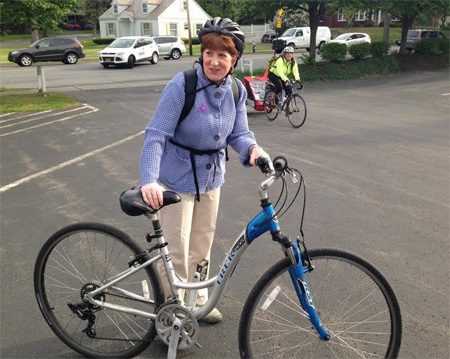 Albany Mayor Kathy Sheehan and Her Bicycle
Albany Mayor Kathy Sheehan and Her Bicycle
Recently a friend explained to me the process of our national decline by repeating the old saw, a fish rots from the head first. I don’t know if that’s a strict rule for either piscines or for human societies, but it’s apparent that most of our State and federal politicians are corrupt tools who work for corporations, for foreign governments and for the lazy irresponsible rich, and these tools are dragging our economy and our very souls into a bottomless pit. We Albanians are quite familiar with institutional corruption, but somehow us locals seem to be getting beyond decline and past the stink of rotting fish.
Take this recent small but significant indicator of change as an example. Less than ten years ago the Albany police were routinely harassing bicyclists, treating bicycles as roadway obstructions and bicycle drivers as criminals, terrorists or worse. Until all too recently, whenever a bicycle driver was mowed down by a car, the police would automatically pass judgement against the dead or injured bicyclist and not even ticket the car driver, no matter how obviously responsible was the auto driver for the collision.
There were several reasons for this open discrimination against bicyclists. One was the usual cultural reason, most Albany cops and many City officials grew up in the suburbs where bicycles are considered a toy that one should never take onto a road. And, believe it or not, eight or ten years ago the local FBI was spreading the story that bicyclists are terrorists, which reinforced suburbanist attitudes. But the main reason that bicycles and their drivers were harassed and discriminated against was that the Old Boy kleptocrats who ran the Albany City government had no use for bicycles and didn’t want them cluttering up their streets and getting in the way of cars driven by suburban commuters.
 Bicycle Drivers Ready To Roll At Bethany Reformed Church (State Assembly Member Pat Fahy At Right)
Bicycle Drivers Ready To Roll At Bethany Reformed Church (State Assembly Member Pat Fahy At Right)
However, survey after survey for the past 20 years has returned the same result, a strong majority of Albany citizen taxpayers want to live in “walkable, bikeable neighborhoods.” By the turn of the decade pro-bicycle activism had developed from several directions and had become annoying, forcing the Albany City authorities to grudgingly retreat from their anti-bicycle attitudes. In the last few years of his administration, former mayor Jerry Jennings even made some concessions to the idea of urban bicycling, but nothing that seriously encouraged bicycling or promoted safety for bicyclists.
But with the new regime of current mayor Kathy Sheehan there has been a total reversal of attitudes toward bicycling. This is part of the wider policies that swept her into office, that of putting the neighborhoods and the citizens of Albany first, that is, aligning planning initiatives so that the needs of City taxpayers are considered above those of commuters and other outsiders. That this is considered a radical change of attitude shows how far down this City had sunk in the last 20 years or so.
 Stopping At The Downtime On Madison Avenue, Mayor Sheehan (Center)
Stopping At The Downtime On Madison Avenue, Mayor Sheehan (Center)
Former mayor Jennings followed a policy of accommodating daily commuters and other suburban “visitors” (as he called them) above all else. One clear ongoing example was his choice of which roadways received priority funding for rebuilding and maintenance. The main commuter routes into the City received the most attention, Western Avenue, Delaware Avenue, Northern/Henry Johnson Boulevard and of course, New Scotland Avenue. Meanwhile local neighborhood streets and sidewalks were lucky to get plowed after snowstorms, unless of course they were commuter routes.
Making it okay to drive bicycles in Albany appears to be a little thing, but as an issue it sits right in the middle of a major urban vs. suburban controversy, to whom do City streets belong? Do the streets exist exclusively for cars, most of which are driven by outsiders, or do streets exist so that citizens of the City neighborhoods can use them for walking or pedaling without fear of being mowed down by vehicles?
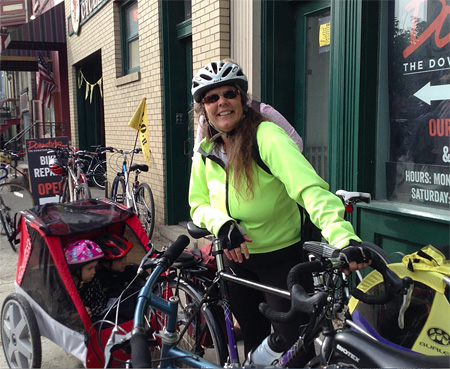 Claire Nolan and Her Grandkids In Tow
Claire Nolan and Her Grandkids In Tow
So on a Friday morning in the middle of May I had to kick The Wife out of bed so that she could ride with mayor Sheehan on Bike To Work Day. She threw her bike onto the back of the car and I drove her up to the parking lot of Bethany Reformed Church, which is on the big bend of New Scotland Avenue way up past St. Peter’s Hospital. Sure, she should have bicycled over there but running late as she was, it really wasn’t a good idea for her to fight the crowded and aggressive commuter traffic that always clogs up the roads that early in the morning.
We made it in plenty of time, and at 8 AM the mayor led about thirty or so bicyclists out of the church parking lot and into the heavy traffic of New Scotland Avenue at rush hour. Driving bikes with them were three Albany police officers, the mayor in the lead and a police car behind as sweep. This was serious critical mass. It was an official bicycle parade and the suburban commuters in their belching, darting cars had to put up with it and give the City of Albany bike drivers right of way.
 On Madison Avenue Taking Off For City Hall
On Madison Avenue Taking Off For City Hall
In no time at all the parade made it over to the Downtube Bike Shop on Madison Avenue for a very brief press conference. Earlier this year Downtube sustained serious water damage from an upper story fire, but somehow they have managed to partially stay open while repairs are made, and I hear that because they have excellent insurance they are even able to continue paying idle employees. After that mayor Sheehan led the bicyclists to City Hall and invited them inside her conference room for coffee and bagels. They brought their bikes inside and no one had to pass through the security theater checkpoint.
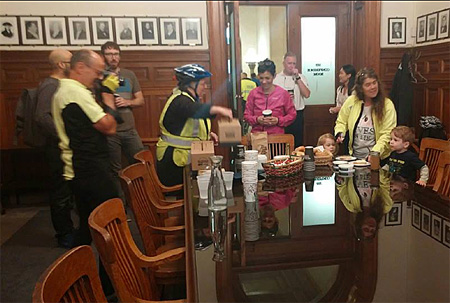
Coffee And Bagels In The Mayor’s Conference Room
Of course the mayor has bigger problems to deal with than bicycle safety. Just about every neighborhood in the City has been struggling with decline, the loss of population and the attendant loss of prosperity. The good news is that this decline appears to have slowed to a stop and living conditions are starting to trend toward improvement.
Some Albany neighborhoods way uptown have fared okay under the last three administrations, not great but not too badly. It was the downtown neighborhoods that were encouraged to rot and became empty of inhabitants. It’s no exaggeration to say that some downtown neighborhoods came to resemble bombed out Cities in the Middle East, it took a lot of planning to make them that way.
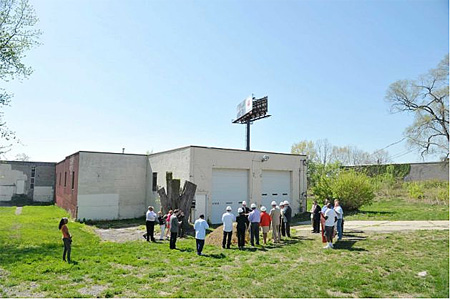
The Lot At 418 South Pearl Street
South Pearl Street in the South End has been a sad mess for a long time, with a lot of empty storefronts and abandoned 19th Century buildings. It wasn’t always like that. When the nearby neighborhoods were packed with working class people of a variety of ethnic origins, and when the Port Of Albany was a bustling provider of a steady stream of good temporary jobs, the street thrived. South Pearl has never had the high-class polished demeanor of other downtown areas like lower State Street, but it used to be a practical and affordable retail and business district that attracted people from all over.
But in the last quarter of the 20th Century the nearby neighborhoods emptied of people and the Port of Albany was allowed by our local governments to languish and decay. For a while now South Pearl has not been the sort of street one wanders around at night, not unless one is very familiar with the people who live along there and with the nearby neighborhoods. Even in the middle of the day anyone perceived as an outsider is made to feel unwelcome, a stranger is frequently asked to explain one’s reason for walking down the street.
Fifteen years into the 21st Century there is a growing attitude that this situation needs to change, both from concerned citizens of the South End and from City officials. The general understanding is that South Pearl Street can only come back to life with private investment encouraged by steady government support. But that is not enough, that private investment has to respectful, a positive addition to the community and not another exploitative scam or money extracting operation that further degrades the street.
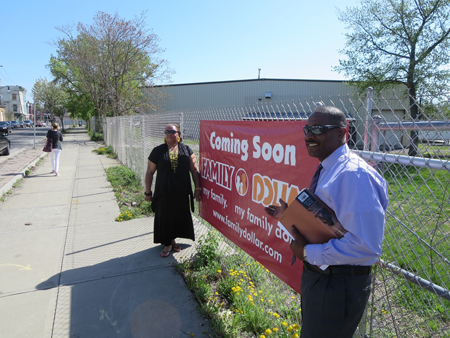
2nd Ward Council Member Vivian Kornegay And
Willie White Of AVillage
And so the latest private investment initiative is the construction of a new building that will host a Family Dollar, a national chain department store and grocery outlet. It took two years to bring this store to this desolate lot at the bottom of Second Avenue, located on the east side of the street which is mostly industrial. Neighborhood support, particularly from Joann Morton of the South End Neighborhood Association (SENA) and Second Ward Common Council Member Vivian Kornegay were vital to obtaining approvals from the City.
The first problem was that the lot was zoned Light Industrial, which meant that the Board of Zoning Appeals (ZBA) had to approve. The representatives of Family Dollar were under the impression that they only needed a variance, in other words an official exception to the zoning designation that would allow a retail outlet to be built in an industrial area. But after going through the process they were told that they needed a complete change of zoning and would have to reapply. That killed quite a few months.
In a recent presentation I heard Chris Spencer, the Directer of Planning for the City of Albany, declare that the current approvals process is bad, “it drives away developers.” Part of the problem with the current system, he said, is that the code is full of contradictory language and mostly says what is not allowed rather than what is wanted. This, I might add, suited the Old Boy kleptocrats of the last three administrations who could pretty much dictate their own preferences for development without having any hard and fast rules to break.
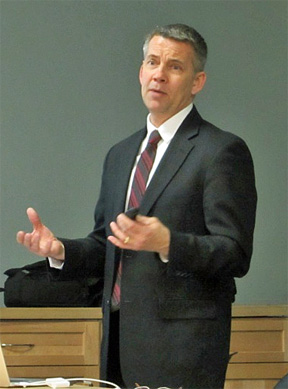
City Of Albany Planning Director Chris Spencer
The other problem with the current system, he told us, is that it is based on the separation of uses, that is, residences must be located exclusively inside this zone, commercial inside that zone, industrial in that one. Mr. Spencer did not add the obvious, that this suits suburban sprawl but is completely absurd when applied to older urban neighborhoods that are composed of mixed uses. In fact, this kind of boneheaded suburban type zoning has had a devastating effect on downtown neighborhoods such as this stretch of South Pearl Street.
The good news here is that the City is currently revising the zoning process, a massive undertaking called ReZone Albany. The idea is to establish “form-based zoning,” to lay out exactly what is wanted for a building built inside a particular zone, things like specific size, height, and distance from the street, but also allowing whatever mix of uses are traditional for each neighborhood. Special attention is paid to transition areas where zones meet, to “look at the edges to lessen tension,” as Mr. Spencer put it.
This revamping of zoning, which started last year, is an outgrowth of the Albany 2030 planning process. Like the bigger process ReZone has included public meetings to solicit input, but there hasn’t been much of a response from the public. On the other hand, the ReZone initiative could certainly be better advertised. Zoning may be awfully boring for most people but such local rules affect our daily lives more directly than things like presidential elections and Supreme Court decisions.
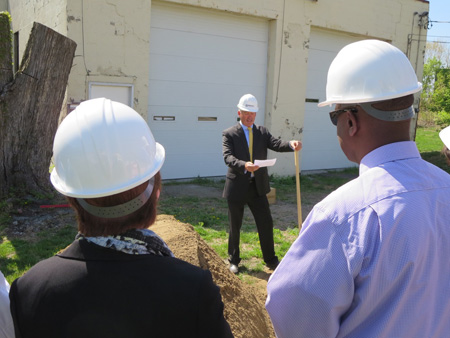
Project Managing Director Ken Brownell Makes A Statement, Mayor Sheehan And Willie White Listen
After submitting the inevitable State Environmental Quality Review (SEQR) statement, the Family Dollar representatives had to go before the Historic Resources Commission (HRC.) Now, you might wonder how a desolate lot in a Light Industrial district would fall under their purview. There is currently a large garage type building being used for storage on the lot, and since for some reason the industrial lots and buildings on this side of the street happen to fall into the weird and illogical patchwork of historic districts, the HRC has final say over what goes there.
Plenty of developers and homeowners both big and small have complained over the years that the HRC has effectively stopped them from building and rebuilding inside these downtown historic districts. In past years the HRC has been used for that purpose by corrupt City officials and by loose cannon outfits like Historic Albany Foundation (HAF) to discourage development. The reasons for such behavior can be summed up as petty and personal without the slightest interest in promoting the good of the community.
In this case the HRC did manage to compel some positive changes to the design of 8300 square foot one story building so that it sits close to the sidewalk and places the parking lot to the north side of the building instead of in front. There will also be windows in front so that we don’t have a blank wall threatening the passersby. And of course the garage will be demolished, and the lot will be raised about six feet with clean fill and leveled off.
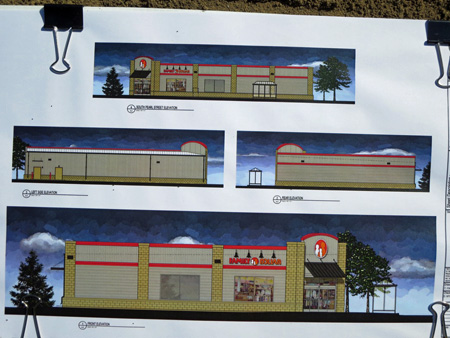
The Finished Building, Top Faces The Street,
Bottom Faces The Side Parking Lot,
Trees Are Totally Superfluous, Note The Bus Shelter
Finally it seems that the garage must undergo asbestos abatement before it is demolished because of the roof shingles. As a hazard to health this is a downright trivial problem, but State regulations require all materials containing asbestos to be removed by a licensed asbestos abatement company, which is a slow and expensive procedure. The roofing will end up in the Rapp Road Dump in the Pine Bush like everything else does, but procedures must be followed and construction of the building will not be able to start until later this year.
We had a ribbon cutting earlier this month, a low key affair attended by interested members of the community, various executives and project managers, City Planning Department employees who desperately needed the sunshine, and of course elected officials. There was one print reporter and a blogger but no TV. We had the obligatory mound of dirt so that a select group of important persons could put on white hardhats and use shovels spray painted gold so they could pretend to work for 30 seconds.
Mayor Sheehan gave a brief speech. “The South End is coming back,” she said. “This new construction is a symbol of hope. It starts with hope, it’s the job of the City to encourage hope.” The significance here is that in this part of the City we are still at the encouraging hope stage, or to put it another way, still developing pride in the neighborhood. This is not just platitudes, one thing that has been instrumental in Albany’s past decline has been an attitude among both the citizens of the City and outsiders that decline is inevitable.
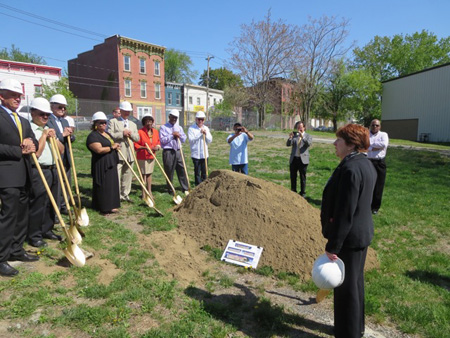
Mayor Sheehan Remarks
I talked to the mayor for a few minutes, she told me the City has been following market studies that have confirmed what most downtown landlords know, that demand for apartments is tremendous and growing, even more than the demand for owner occupied houses. She told me the City is committed to planning for the construction of 100 to 200 new units per year for the next ten years, and so far has been exceeding that goal. But still, if you add up all the projects that are currently in the pipeline the City is only going to meet about 50 percent of demand.
I’ve heard repeatedly from City officials that the goal is to create mixed income communities downtown rather than what I would call Class Ghettos separating the rich, the poor and the middle classes as is common in the suburbs. The City’s role has been to jump start private investment of construction, according to Darren Scott of Albany Housing Authority (AHA) this investment by private entities has not yet happened on a large scale. Apparently there has to be more strategizing on how to go about reaching that “tipping point,” hopefully this new Family Dollar building is a step in that direction on South Pearl Street.
Ten years ago the City government was still interested only in promoting sprawl development in the western part of the City, a policy that went hand in hand with the policy of promoting decline in the downtown neighborhoods. Today we see a reversal of this anti-urban foolishness. Westward sprawl has crawled to a near stop thanks to citizen opposition, most notably because of the efforts of the environmental group Save the Pine Bush.
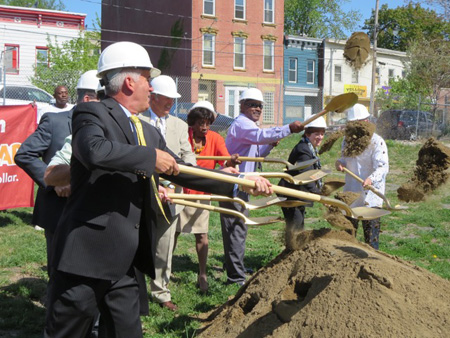
Finally Some Action: Agitating The Dirt
Now downtown neighborhood development is the priority. My theory has been that since the politicians can’t generate graft by promoting sprawl in the Pine Bush they have no choice but to collect their payoffs by rebuilding downtown. Well, so far I haven’t seen any evidence that Kathy Sheehan and her administration is stealing from the taxpayers, and I think it unlikely that she will slip back into traditional behavior in that regard.
The mayor isn’t perfect and she isn’t delivering any overnight miracles. But since she has taken office the fiscal problems are being confronted head on, the bureaucracy is becoming more efficient and more responsive, and the number of housing units is increasing. Now that they don’t have to deal with the Old Boy kleptocracy anymore, developers and business people are starting to move into Albany instead of moving out.
And most amazing of all, the population of the City of Albany is going up for the first time in over 50 years. We will be back over 100,000 residents in a year or so, and some say we are on track for 125,000 residents by the next census in 2020. I’ll say it again and again, if you want to invest in the future the City of Albany is the place right now. But hurry up if you want to buy in, the opportunities won’t last forever.

Ornamental Apple Tree Near My House That Same Morning